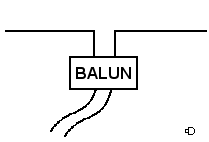



| |
Section 4
Feeders and Antenna
Baluns
4B1 Recall the difference between balanced and unbalanced antennas and that a balun should be used when feeding a dipole with coaxial cable (which is unbalanced)/p>
A balanced antenna is a centre fed dipole, equal length legs symmetrically either side of the centre connector (hence balanced), whilst a quarter wave vertical and five eights wave vertical are unbalanced as they are not symmetrical.

If you look at a dipole you would see that it is made up of two identical length "legs" which are linked at the centre by some form of insulated joint which keeps each leg apart from the other and allows you to link it to the feeder. Often the feeder used on a dipole is the open wire feeder as it too is a balanced feeder but many amateur prefer to use a co-axial feeder which is an unbalanced feeder but a "Balun" is used to link the BAL anced antenna to the UN balanced coaxial feeder.
The choke balun can simply be several turns of the coaxial feeder (say about 6 turns of the coax of 150mm diameter) or more complex by the use of ferrite ring or ferrite bar. A choke balun as it is there to choke off / stop any RF that might try to pass down the braiding rather than the centre of the coax.
Suffice to say what you need to know for the written assessment is that :- a balun should be used when feeding an H.F. dipole with coaxial cable.
The origin of some of the text on this page is from the RSGB with additions by the web master